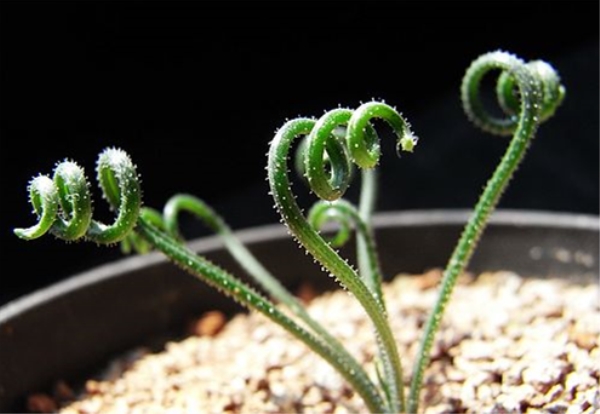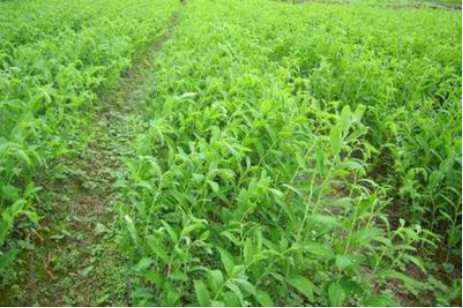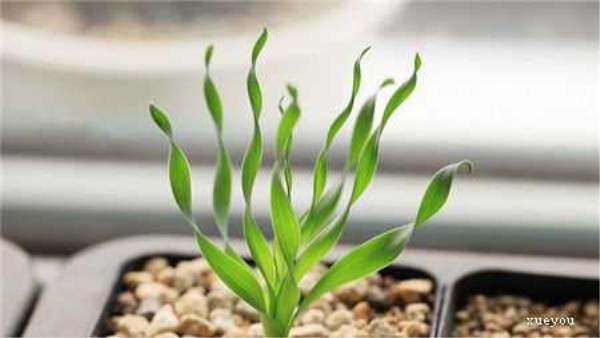Key points for the maintenance of Spring Grass
Change the basin
The growth of spring grass needs to be changed every year to provide it with adequate nutrients. We generally choose to change the basin at the end of August, the basin soil requires fertile and loose, rich in humus, with good drainage and air permeability.

Light
Spring grass likes light, so in the growing period we should give sufficient light, if the lack of light will lead to weak leaves, and the degree of curl is poor, it is difficult to highlight the unique charm of spring grass.
How to raise spring grass? Culture methods and matters needing attention of Spring Grass
Spring grass
[FAQ] how to raise spring grass? What are the breeding methods and matters needing attention of spring grass?
[expert's answer] the breeding methods and points for attention of spring grass are as follows:
1. Temperature: no less than 5 ℃ can safely survive the winter.
2. Light: spring grass likes light, and sufficient light should be given during the growing period. if the light is not enough, it will make the leaves weak and the degree of curl is poor, so it is difficult to highlight the unique charm of spring grass. On the other hand, the leaves of the plants growing in sufficient sunshine are low and stout, twisted and twisted, with high ornamental value, but sunshade nets should still be built after April to avoid hot sun exposure and prevent leaf tips from drying up.
Spring grass
3. Water and fertilizer: spring grass likes a humid environment, and it is appropriate to keep the soil moist during the growing period without stagnant water. if there is a long-term drought and lack of water, the plant will not die, but the growth will stagnate, the leaves will yellowing, and even withered; while the basin soil will cause bulb rot for a long time. Water can often be sprayed to the plant to increase air humidity and prevent the top of the leaves from drying up. In summer, in order to avoid flooding in the rainy season, the flowerpot can be placed on the shelf or on a stage with a certain height, and pay attention to control watering to prevent the bulb from rotting due to stagnant water, but the pot soil can not be completely dry to prevent the bulb from drying up. The peak period of plant growth is from October of each year to April of the following year. Mature thin liquid fertilizer or compound fertilizer is applied once a month to provide sufficient nutrients to make the plant grow vigorously. After the flower is extracted in spring, 0.5% potassium dihydrogen phosphate solution is sprayed 2 to 3 times to promote flowering.
4. Pollination: after flowering, different plants should be selected for artificial pollination to make the plants bear fruit, and the seeds should be harvested after maturity, so as not to scatter them; if there are no seeds, the remaining pedicels should be cut off in time after flowering so as not to consume too much nutrients.
5. Change the basin: spring grass is generally changed once a year at the end of August. The basin soil is required to be fertile and loose, rich in humus, and has good drainage and permeability. It can be mixed with 3 portions of rotten leaf soil or peat soil, 2 parts of vermiculite or sandy soil, and mixed with a small amount of bone powder. Cut off the rotten root system when changing the basin, plant the bulb out of the soil 1 / 3 or so, pour water after planting and maintain it in a place with sufficient light. After that, pay attention to keep the soil moist, and soon new leaves will grow from the top of the bulb.
[conclusion] Spring grass is a kind of plant that likes cool and afraid of heat. It hibernates in summer. September to April is its growing period, but the winter temperature can not be lower than 5 degrees. I hope this article will be helpful to you.
The key points for the conservation of Albuca spiralis, the succulent plant, Albuca spiralis, Hyacinthaceae (Albuca). Steel wire spring grass is also called spiral grass because its leaves twist and spiral like a spring. Steel wire spring grass (Hyacinthaceae) Albuca belongs to the perennial bulb succulent plant, the plant has a round or olive-shaped bulb, its bulb is composed of layers of thick fleshy scales, the underground part of the epidermis is yellow-white, the exposed part of the soil scale will dry up after the sun. Fleshy leaves are drawn from the top of the bulb, semicircle, twisting and twisting gradually, much like a spring, hovering more evenly and falling down after getting higher and higher. Steel wire spring prairie produced in South Africa, like cool, moist and sunny environment, afraid of hot and humid, resistant to semi-shade, but also resistant to drought, has a certain degree of cold resistance. It has the habit of dormant at high temperature in summer and growing in the cool season from autumn to spring. Steel spring grass likes cool and afraid of heat, and its main growth period is from September to April of the following year. It is advisable to maintain a temperature of 5 ℃ to 20 ℃ in winter, in which the plant can continue to grow and carry out normal fertilizer and water management. If watering is controlled to make the plant dormant, no less than 0 ℃ can safely survive the winter indoors. In the middle and last ten days of May, with the increase of temperature, the leaves on the ground gradually withered, the plant went into a dormant state, the dry leaves could be removed, the bulbs were left in the original pot for summer, and the flowerpot should be placed in a dry, ventilated and water-free place until the end of August and the beginning of September. As the weather turns cool, new buds will grow from the bulbs, and normal management can be slowly restored. It is worth reminding that summer dormancy, plants do not have no water throughout the summer, can stay slightly moist, although the leaves have dried up. Underground bulbs will still grow, do not water in the center of dry leaves, over a summer, the bulbs grow a lot bigger. Spring grass likes light, should be given sufficient light during the growing period, if the lack of light will make the leaves weak, and the degree of curl is poor, it is difficult to highlight the unique charm of steel wire spring grass. On the other hand, the leaves of the plants growing in sufficient sunshine are low and stout, twisted and twisted, with high ornamental value, but sunshade nets should still be built after April to avoid hot sun exposure and prevent leaf tips from drying up. Steel wire spring grass likes a humid environment, and it is appropriate to keep the soil moist during the growing period without stagnant water. if there is a long-term drought and lack of water, the plant will not die, but the growth will stagnate, the leaves yellowing and even withered; while the long-term stagnant water in the basin soil will cause the bulb to rot. Water can often be sprayed to the plant to increase air humidity and prevent the top of the leaves from drying up. In summer, in order to avoid flooding in the rainy season, the flowerpot can be placed on the shelf or on a stage with a certain height, and pay attention to control watering to prevent the bulb from rotting due to stagnant water, but the pot soil can not be completely dry to prevent the bulb from drying up. The peak period of plant growth is from October to April of the following year, and the mature thin liquid fertilizer or compound fertilizer is applied once a month to provide sufficient nutrients and make the plant grow vigorously. Steel wire spring grass can carry out artificial cross-pollination after flowering, so that the plant can bear fruit, and pay attention to harvest the seeds after maturity, so as not to make them scattered; steel spring grass is generally changed once a year at the end of August (because the long slow can be changed once every 2 to 3 years). The basin soil is required to be fertile and loose, rich in humus, with good drainage and air permeability, and can be mixed with 3 parts of rotten leaf soil or peat soil, 2 parts of vermiculite or sandy soil. The kite uses peat mixed with cinder, adding a small amount of perlite and vermiculite, and laying river sand on the soil surface. Cut off the rotten root system when changing the basin, plant the bulb out of the soil 1 / 3 or so, pour water after planting, keep the soil moist, and wait for new leaves to grow from the top of the bulb. you can see the sun step by step. Spring grass can be propagated by sowing, not fond of varieties with long lateral buds. Sowing: this method is suitable for mass reproduction and is carried out in autumn. After sowing, it is covered with thin soil and covered with glass to keep the soil and air moist and has a high emergence rate. After sowing and at the seedling stage, in order to avoid flushing the seeds or seedlings out of the soil during watering, you can soak the soil slowly by soaking water from the drainage holes at the bottom of the flowerpot. Detailed sowing reference kite sowing paste. There are not many diseases and insect pests in steel spring grass, which are mainly harmful to bulbs, such as snails and nematodes in the soil. When planting, the soil can be treated at high temperature to kill pests and eggs in the soil, and insecticides such as carbofuran can also be mixed in the cultivated soil.
- Prev

Culture methods of Polygonatum odoratum
1. Soil. Polygonatum odoratum is suitable to grow in sandy soil with deep soil layer, good drainage and slightly acidic soil, and pay attention to changing the soil every other year when planting, so as to ensure the supply of nutrients for the growth of Polygonatum odoratum. 2. Seed sprouting. Polygonatum odoratum should be planted and germinated before sowing.
- Next

Matters needing attention in culturing spring grass
There is a great demand for nutrients during the growth period of spring grass, so we need to apply mature dilute liquid fertilizer once a month to promote plant growth. When blooming in spring, you can spray some phosphate fertilizer to promote flowering. The above is the introduction of the breeding methods and matters needing attention of spring grass.
Related
- Fuxing push coffee new agricultural production and marketing class: lack of small-scale processing plants
- Jujube rice field leisure farm deep ploughing Yilan for five years to create a space for organic food and play
- Nongyu Farm-A trial of organic papaya for brave women with advanced technology
- Four points for attention in the prevention and control of diseases and insect pests of edible fungi
- How to add nutrient solution to Edible Fungi
- Is there any good way to control edible fungus mites?
- Open Inoculation Technology of Edible Fungi
- Is there any clever way to use fertilizer for edible fungus in winter?
- What agents are used to kill the pathogens of edible fungi in the mushroom shed?
- Rapid drying of Edible Fungi

